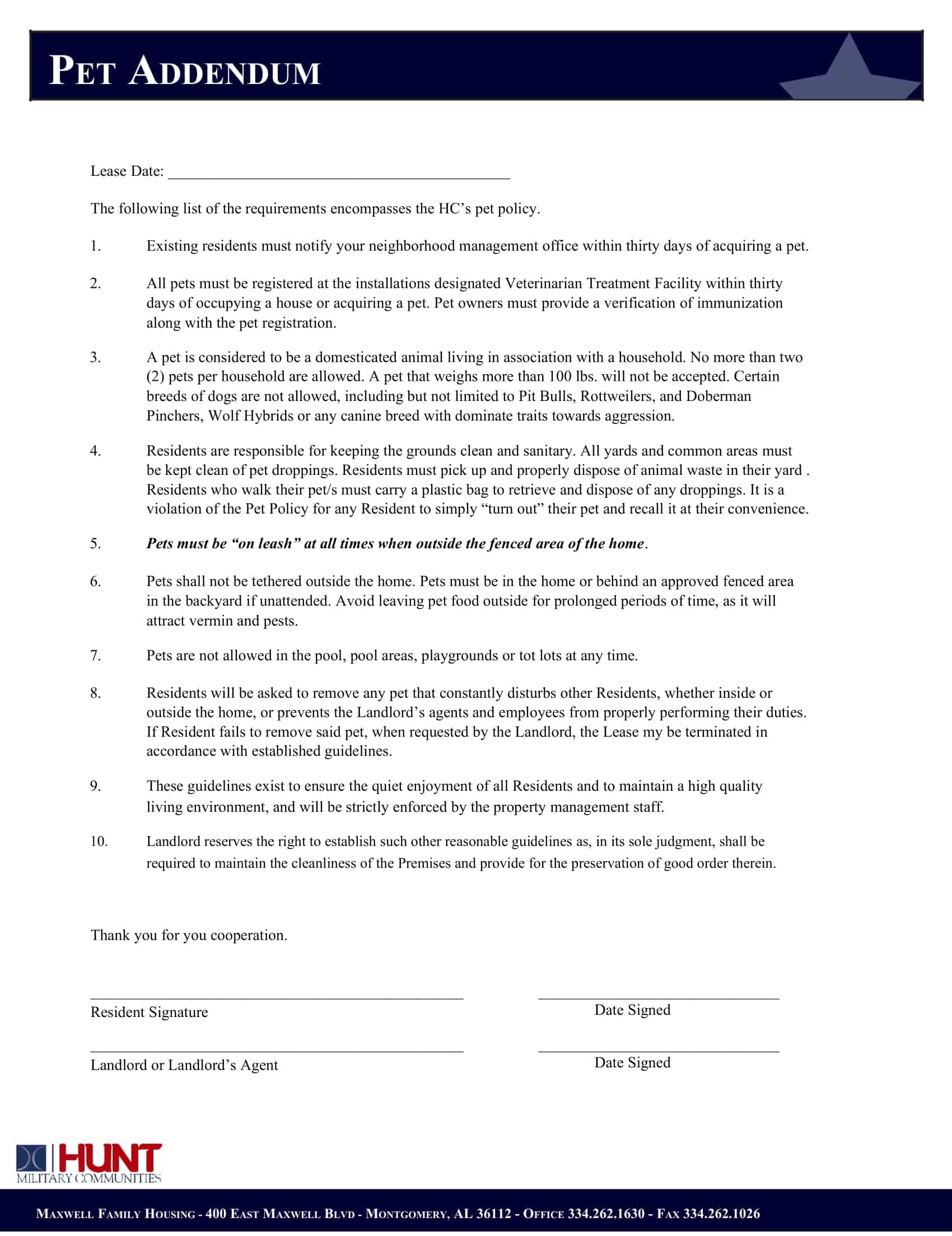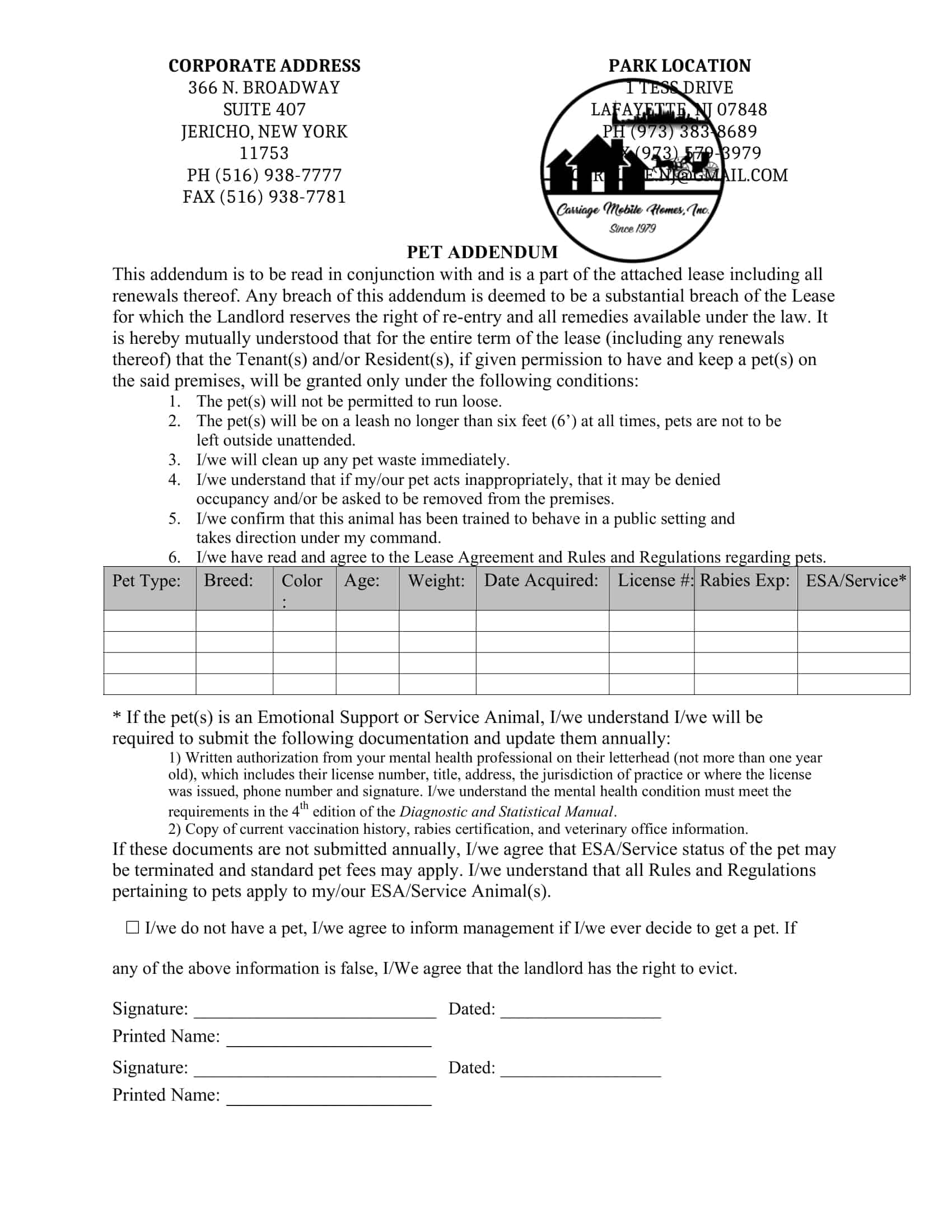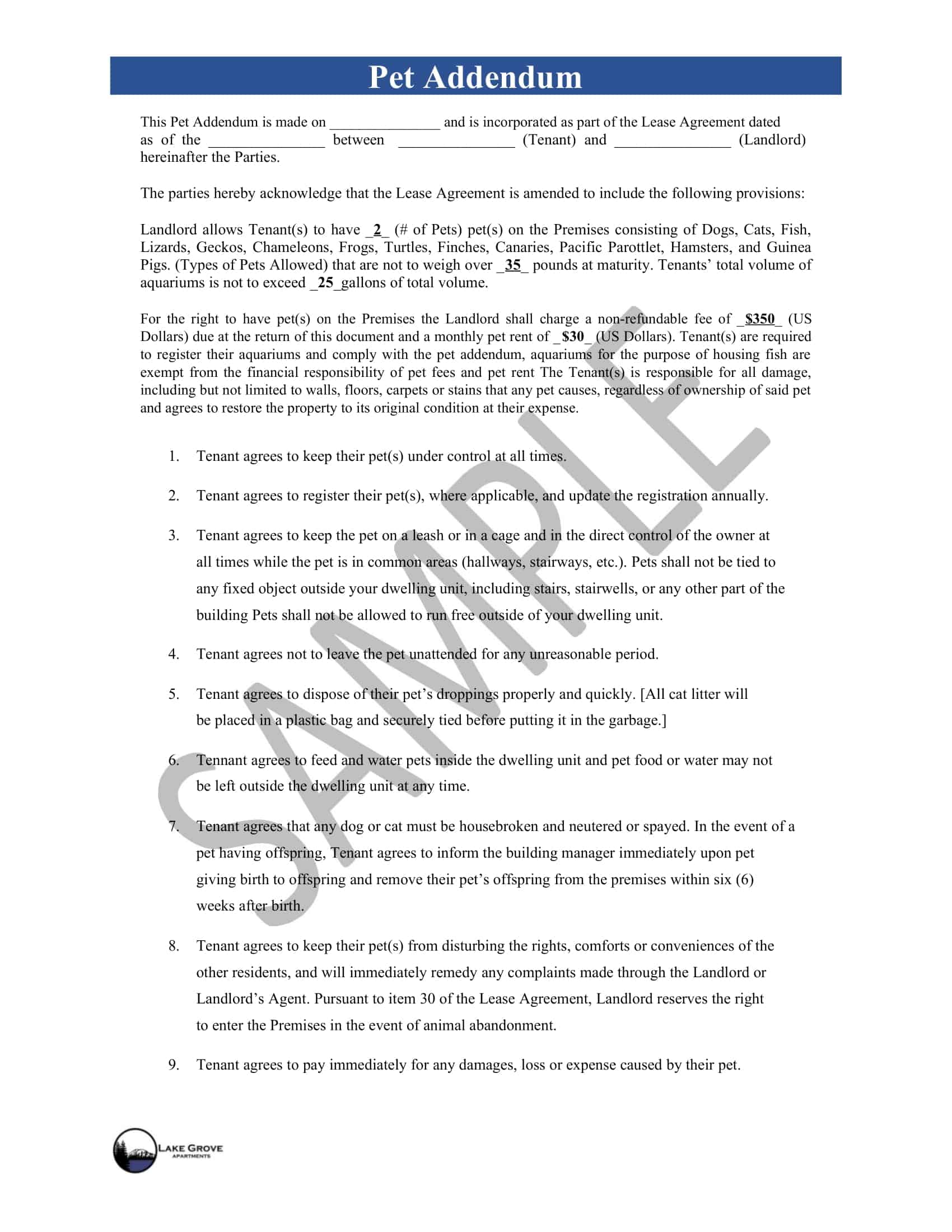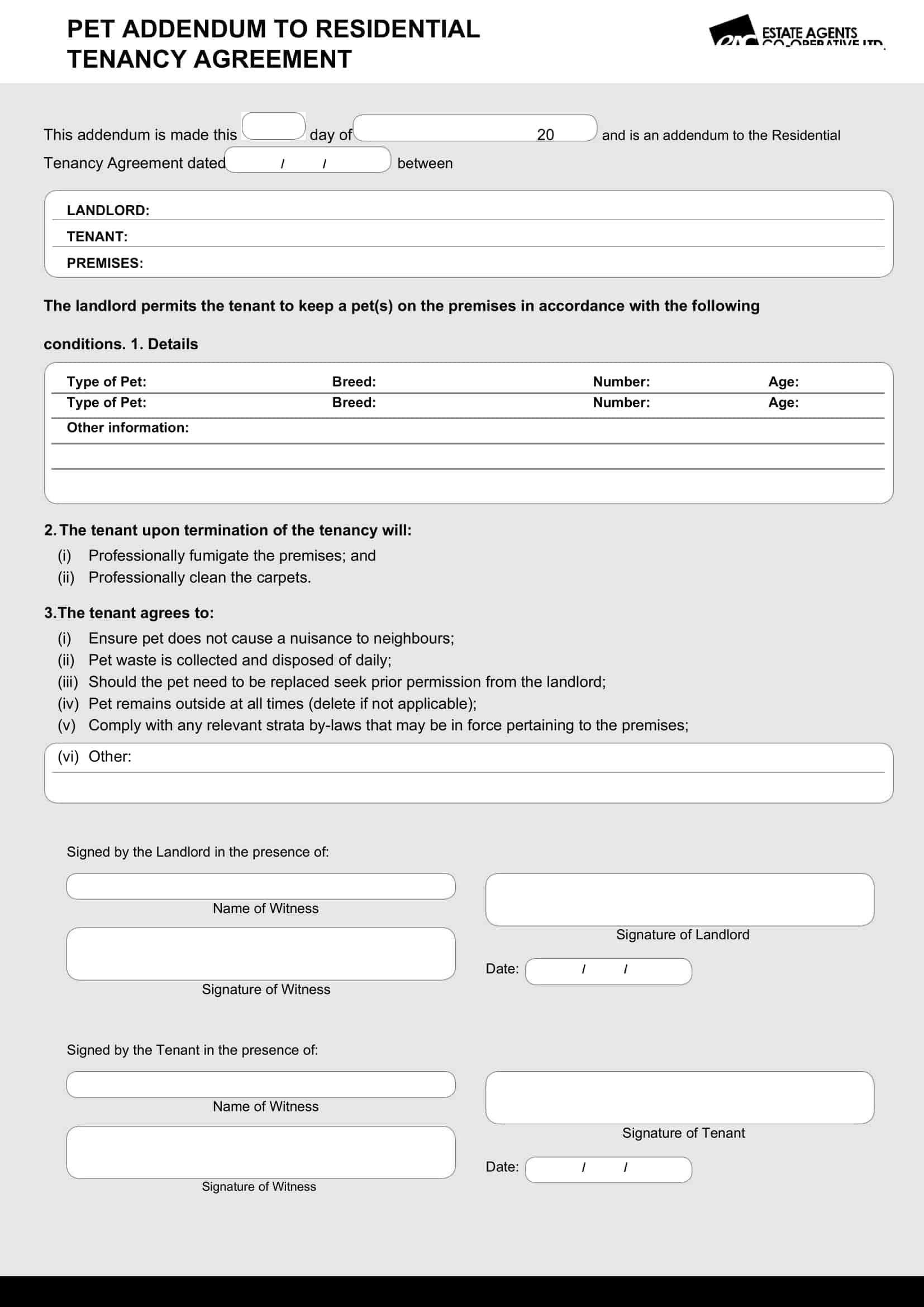A pet addendum is a document that outlines the terms and conditions of having a pet in a rental property. This addendum is added to the original lease agreement and outlines specific guidelines for pet owners to follow. The purpose of a pet addendum is to protect the property from damage caused by the pet and to provide a clear understanding of the responsibilities of both the landlord and the tenant.
A pet addendum can also include details such as pet-related fees, restrictions on the number and size of pets, and any requirements for pet owners to provide proof of vaccinations or liability insurance. With the increasing number of households owning pets, a pet addendum is becoming an important aspect of rental agreements for many landlords.
Table of Contents
Pet Addendum Templates
“Pet Addendum Templates” are pre-designed documents that provide a comprehensive framework for adding or modifying pet-related provisions in a rental or lease agreement. These templates serve as valuable tools for landlords and tenants to establish clear guidelines and conditions regarding pet ownership in rental properties.
A pet addendum is an additional document attached to a lease agreement that outlines the specific terms, rules, and responsibilities related to pets residing in a rental property. Pet addendum templates cover various aspects such as pet types and breeds allowed, pet deposit or fees, pet care responsibilities, noise and cleanliness requirements, and any restrictions or limitations imposed by the landlord.
By utilizing pet addendum templates, both landlords and tenants can ensure a fair and transparent agreement regarding pet ownership. These templates are often created or reviewed by legal professionals or property management experts to ensure compliance with relevant laws, regulations, and community policies.
When Do I Need a Pet Addendum?

A pet addendum is necessary when a tenant wishes to bring a pet into a rental property. This addendum is added to the original lease agreement and outlines specific guidelines and policies related to having a pet in the property. A pet addendum is important because it helps to protect the property from damage caused by the pet and clarifies the responsibilities of both the landlord and the tenant.
Some landlords have strict policies regarding pets, and a pet addendum can provide a clear understanding of what is expected of the tenant and their pet. Additionally, a pet addendum can outline any fees or deposits related to having a pet in the property, as well as any restrictions on the number and size of pets. In short, if a tenant wishes to bring a pet into a rental property, they will likely need to sign a pet addendum as part of their lease agreement.
What to Include in a Pet Addendum?
A pet addendum should include specific details related to having a pet in the rental property. Here are some key elements that should be included in a pet addendum:
Definition of a pet: The pet addendum should clearly define what is considered a pet, including types of animals and any restrictions on the number or size of pets allowed.
Pet fees and deposits: The pet addendum should outline any fees or deposits that the tenant must pay in order to have a pet in the property, such as a pet deposit or monthly pet rent.
Responsibility for damage caused by the pet: The pet addendum should clearly state who is responsible for any damage caused by the pet, including repair costs, cleaning fees, and any necessary extermination services.
Proof of vaccinations and liability insurance: The pet addendum should require the tenant to provide proof of the pet’s vaccinations and liability insurance, which protects the landlord and the property in case of injury or damage caused by the pet.
Pet behavior and noise restrictions: The pet addendum should outline any restrictions on pet behavior, such as barking or jumping, and any rules for keeping the pet quiet during specific hours.
Pet waste removal: The pet addendum should state the tenant’s responsibility for cleaning up after their pet and disposing of pet waste in a responsible manner.
Restrictions on certain breeds: Some landlords may have restrictions on certain breeds of dogs, such as pit bulls or Rottweilers. This information should be included in the pet addendum.
In conclusion, a pet addendum should provide clear and detailed information on all aspects of having a pet in a rental property. It should protect the property, clarify the responsibilities of the landlord and the tenant, and provide a clear understanding of the policies related to pets.
Ways to Cover Pets in Your Lease Agreement
Here are some ways to cover pets in your lease agreement:
Include a pet addendum: A pet addendum is a separate document that outlines specific policies and guidelines related to having a pet in the rental property. The pet addendum should be added to the original lease agreement and signed by both the landlord and the tenant.
Specify pet policies in the lease agreement: You can also include pet policies directly in the lease agreement, rather than creating a separate pet addendum. This approach can help to simplify the agreement and ensure that all pet-related information is in one place.
Include pet fees and deposits: The lease agreement should clearly outline any fees or deposits required for having a pet in the property, such as a pet deposit or monthly pet rent.
Outline pet behavior restrictions: The lease agreement should include restrictions on pet behavior, such as barking or jumping, and any rules for keeping the pet quiet during specific hours.
Require proof of vaccinations and liability insurance: The lease agreement should require the tenant to provide proof of the pet’s vaccinations and liability insurance, which protects the landlord and the property in case of injury or damage caused by the pet.
Specify responsibility for damage caused by the pet: The lease agreement should clearly state who is responsible for any damage caused by the pet, including repair costs, cleaning fees, and any necessary extermination services.
Restrict certain breeds of pets: The lease agreement can also include restrictions on certain breeds of pets, such as pit bulls or Rottweilers.
In conclusion, covering pets in your lease agreement is important to protect the rental property and provide a clear understanding of the policies and responsibilities related to having a pet. By including a pet addendum or including pet-related information directly in the lease agreement, you can ensure that all parties are fully aware of the rules and guidelines related to pets in the property.
How to Write a Pet Addendum to a Lease Agreement
Writing a pet addendum to a lease agreement can be an important step in protecting your rental property and clarifying the responsibilities of both the landlord and the tenant. Here is a step-by-step guide on how to write a pet addendum to a lease agreement:
Step 1: Define what constitutes a pet
The first step in writing a pet addendum is to define what constitutes a pet. This should include the types of animals that are allowed in the property, such as cats, dogs, birds, etc. You can also specify the number and size of pets that are allowed in the property. For example, you may allow two cats but only one dog that is less than 50 pounds.
Step 2: Include pet fees and deposits
The pet addendum should include information on any fees or deposits that the tenant must pay in order to have a pet in the property. This can include a pet deposit or a monthly pet rent. Make sure to specify the amount of the deposit or rent and the conditions under which it will be returned to the tenant.
Step 3: Specify responsibility for damage caused by the pet
It is important to clearly state who is responsible for any damage caused by the pet in the pet addendum. This should include repair costs, cleaning fees, and any necessary extermination services. For example, you may state that the tenant is responsible for paying for any damages caused by their pet, up to a certain amount.
Step 4: Require proof of vaccinations and liability insurance
The pet addendum should require the tenant to provide proof of the pet’s vaccinations and liability insurance. This is important because it protects the landlord and the property in case of injury or damage caused by the pet. You should specify what types of vaccinations are required and the expiration date of the liability insurance policy.
Step 5: Outline pet behavior restrictions
The pet addendum should include restrictions on pet behavior, such as barking or jumping, and any rules for keeping the pet quiet during specific hours. For example, you may state that pets must be kept on a leash while on the property and that they are not allowed to bark excessively.
Step 6: Specify pet waste removal
The pet addendum should state the tenant’s responsibility for cleaning up after their pet and disposing of pet waste in a responsible manner. For example, you may require the tenant to pick up after their pet immediately and dispose of pet waste in a sealed container.
Step 7: Restrict certain breeds of pets
The pet addendum can also include restrictions on certain breeds of pets, such as pit bulls or Rottweilers. If you have restrictions on certain breeds, it is important to clearly state these restrictions in the pet addendum.
Step 8: Include a signature line
The pet addendum should include a signature line for both the landlord and the tenant. This confirms that both parties have read and agree to the terms of the pet addendum.
Step 9: Make copies of the pet addendum
Make sure to keep a copy of the pet addendum with your lease agreement and provide a copy to the tenant.
In conclusion, a pet addendum is an important document that should be included in a lease agreement when a tenant wishes to bring a pet into a rental property. The pet addendum should provide clear and detailed information on all aspects of having a pet in the property and should protect the rental property, clarify the responsibilities of the landlord and the tenant, and provide a clear understanding of the policies related to pets. By following these steps, you can ensure that your pet addendum is comprehensive, effective, and legally binding.
FAQs
Can I restrict certain breeds of pets in my pet addendum?
Yes, landlords can restrict certain breeds of pets in their pet addendum. However, it is important to be aware of fair housing laws and not discriminate against tenants based on their race, religion, or national origin.
What happens if the tenant violates the terms of the pet addendum?
If the tenant violates the terms of the pet addendum, the landlord can take legal action. This could include eviction proceedings or collecting damages caused by the pet.
Can a pet addendum be changed after it is signed?
Yes, a pet addendum can be changed after it is signed, but both parties must agree to the changes and sign the updated document.
Can a pet addendum be used for service animals?
Yes, a pet addendum can include provisions for service animals, but it is important to be aware of the provisions of the Americans with Disabilities Act (ADA), which provides special protections for service animals and their owners. Service animals are not considered pets and are allowed in rental properties even if the landlord has a no-pets policy.
How long is a pet addendum valid?
A pet addendum is typically valid for the duration of the lease agreement. It is up to the landlord and tenant to renew or update the pet addendum if they choose to do so.
Is a pet addendum legally binding?
Yes, a pet addendum is a legally binding document and is enforceable in court. It is important to consult with a lawyer if you have any questions about the legality of a pet addendum.
Can a pet deposit be used to cover damages caused by a pet?
Yes, a pet deposit can be used to cover damages caused by a pet, but it is important to follow the procedures outlined in the pet addendum and applicable state laws. The pet deposit should be used to repair or replace damages caused by the pet, and any unused portion should be returned to the tenant at the end of the lease.
Can a landlord refuse to rent to a tenant with a pet?
Yes, a landlord can refuse to rent to a tenant with a pet, but they cannot discriminate against tenants based on their race, religion, or national origin. Additionally, service animals are not considered pets and are allowed in rental properties even if the landlord has a no-pets policy.







































![Free Printable Roommate Agreement Templates [Word, PDF] 1 Roommate Agreement](https://www.typecalendar.com/wp-content/uploads/2023/06/Roommate-Agreement-150x150.jpg)
![Free Printable Credit Card Authorization Form Templates [PDF, Word, Excel] 2 Credit Card Authorization Form](https://www.typecalendar.com/wp-content/uploads/2023/06/Credit-Card-Authorization-Form-150x150.jpg)
![Free Printable Stock Ledger Templates [Excel,PDF, Word] 3 Stock Ledger](https://www.typecalendar.com/wp-content/uploads/2023/08/Stock-Ledger-150x150.jpg)
